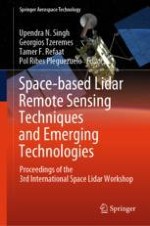2024 | OriginalPaper | Buchkapitel
Future Space-Based Coherent Doppler Wind Lidar for Global Wind Profile Observation
verfasst von : Shoekn Ishii, Kozo Okamoto, Hajime Okamoto, Toshiyoshi Kimura, Takuji Kubota, Shunsuke Imamura, Daisuke Sakaizawa, Koichi Fujihira, Ayako Matsumoto, Izumi Okabe, Tsuyoshi T. Sekiyama, Tomoaki Nishizawa, Tetsuya Takemi, Yoshiaki Miyamoto, Atsushi Sato, Riko Oki, Masaki Satoh, Toshiki Iwasaki
Erschienen in: Space-based Lidar Remote Sensing Techniques and Emerging Technologies
Verlag: Springer Nature Switzerland
Aktivieren Sie unsere intelligente Suche, um passende Fachinhalte oder Patente zu finden.
Wählen Sie Textabschnitte aus um mit Künstlicher Intelligenz passenden Patente zu finden. powered by
Markieren Sie Textabschnitte, um KI-gestützt weitere passende Inhalte zu finden. powered by
